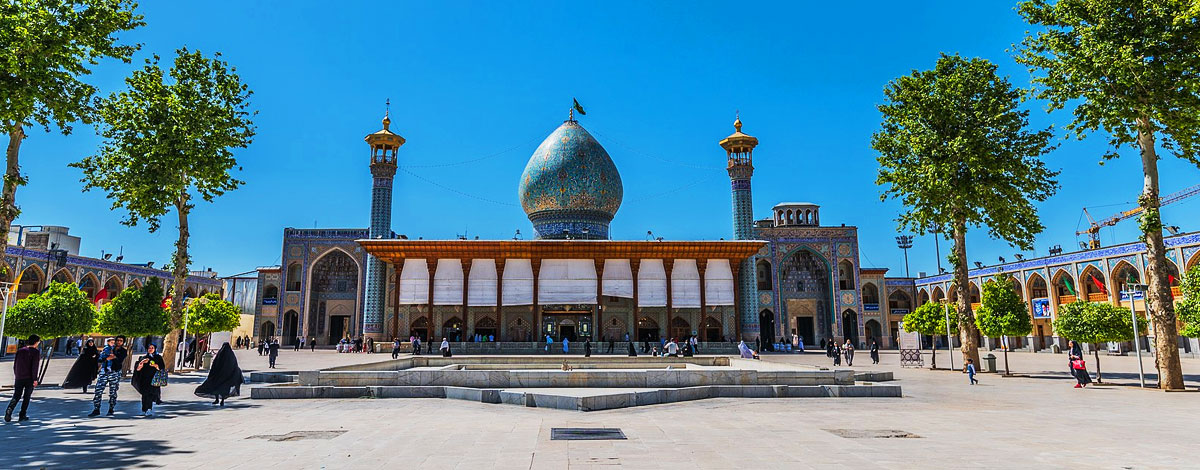Mashhad – The holiest city in Iran and the burial place of Imam Reza, the eighth Shi’a Imam.
Qom – A city known for its religious seminaries and the shrine of Fatima Masumeh, the sister of Imam Reza.
Shiraz – Shah-Cheragh , Shah-e Cheragh, is a mausoleum and mosque located in the city of Shiraz, Iran. The name “Shah-e Cheragh” translates to “King of Light” in Persian. It is considered to be one of the most important pilgrimage sites in Iran.
The mausoleum houses the tombs of two brothers who were descendants of the Prophet Muhammad, and the site is believed to have been a place of worship since the 14th century. The current structure of the mausoleum dates back to the 18th century, with subsequent renovations and expansions over the years.
The interior of the mausoleum is decorated with intricate mirror work, tile work, and calligraphy, creating a dazzling display of light and color. The central chamber is the resting place of the two brothers, and it is surrounded by smaller chambers and courtyards for prayer and reflection.
Shah-e Cheragh is not only a religious site but also an architectural and cultural masterpiece, attracting visitors from all over the world. It is particularly stunning at night when the entire mausoleum is illuminated by thousands of light bulbs, creating a mystical and enchanting atmosphere.
Ardabil – The site of the shrine of Sheikh Safi al-Din, a Sufi saint and the ancestor of the Safavid dynasty.
Tabriz – The site of the Blue Mosque, a famous landmark and pilgrimage site for Shi’a Muslims.
Imamzadeh Hamzah, Tehran – A shrine dedicated to the grandson of the Prophet Muhammad, which is located in Tehran.
Imamzadeh Saleh, Tehran – A shrine dedicated to a descendant of Imam Ali, which is located in Tajrish, a neighborhood in Tehran.
Imam Reza Holy Shrine, Mashhad – The largest mosque in the world, which houses the tomb of Imam Reza and is a popular pilgrimage site for Shi’a Muslims.
Imamzadeh-ye Ali Ebn-e Hamze, Shiraz – A mausoleum that houses the tomb of a nephew of Imam Reza, which is considered to be one of the most beautiful buildings in Shiraz.
The sites mentioned above are the sites which are more popular for the Muslims , specifically Shias . There are some other sites for other religions :
Although Iran is an Islamic country, there are several non-Muslim pilgrimage sites that visitors can explore. Here are some examples:
- Persepolis: This ancient city in southern Iran was once the capital of the Achaemenid Empire and is now a UNESCO World Heritage site. It’s a popular destination for tourists interested in Persian history and architecture.
- Takht-e Soleyman: This archaeological site in northwest Iran is home to a Zoroastrian fire temple that dates back to the Sassanid era. It’s also a UNESCO World Heritage site.
- St. Thaddeus Monastery: Located in the northwestern province of West Azerbaijan, this Armenian monastery is believed to be the burial place of the apostle Thaddeus. It’s a popular destination for Armenian pilgrims.
- Chogha Zanbil: This ancient Elamite complex in southwestern Iran is home to a ziggurat, which was built around 1250 BCE. It’s another UNESCO World Heritage site and attracts visitors interested in ancient Mesopotamian history.
- Tomb of Cyrus the Great: Located in the city of Pasargadae in southern Iran, this tomb is believed to be the final resting place of Cyrus the Great, the founder of the Achaemenid Empire. It’s a popular destination for history enthusiasts.
You can visit a combination of these sites , to see the difference that religion can have on architecture . We can help you organize a diverse religious package. Contact us to start the process.










